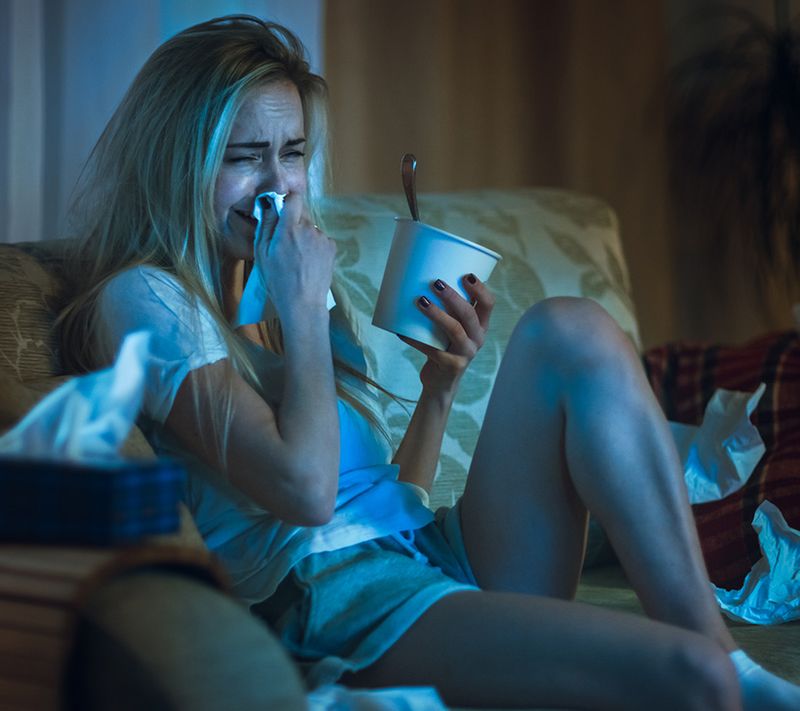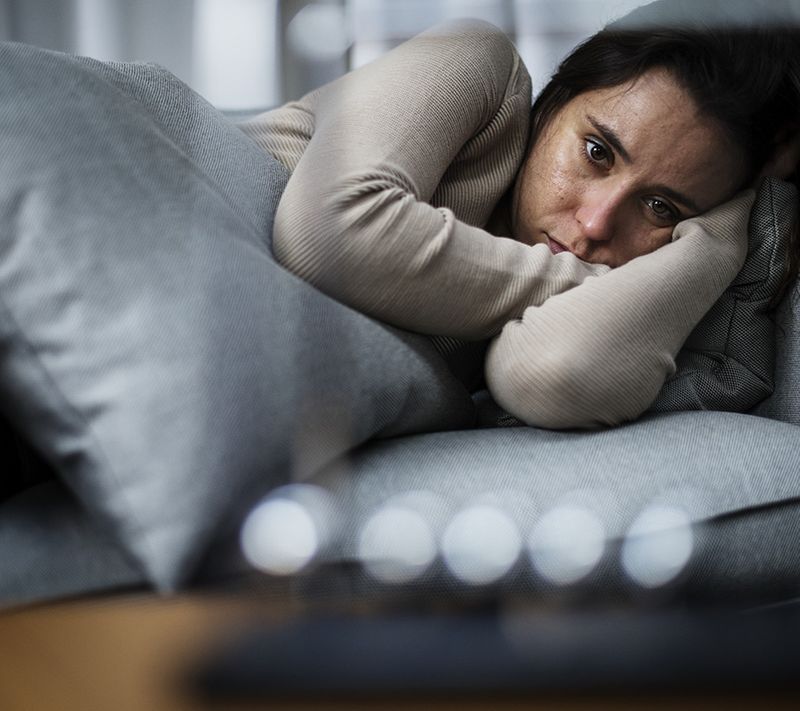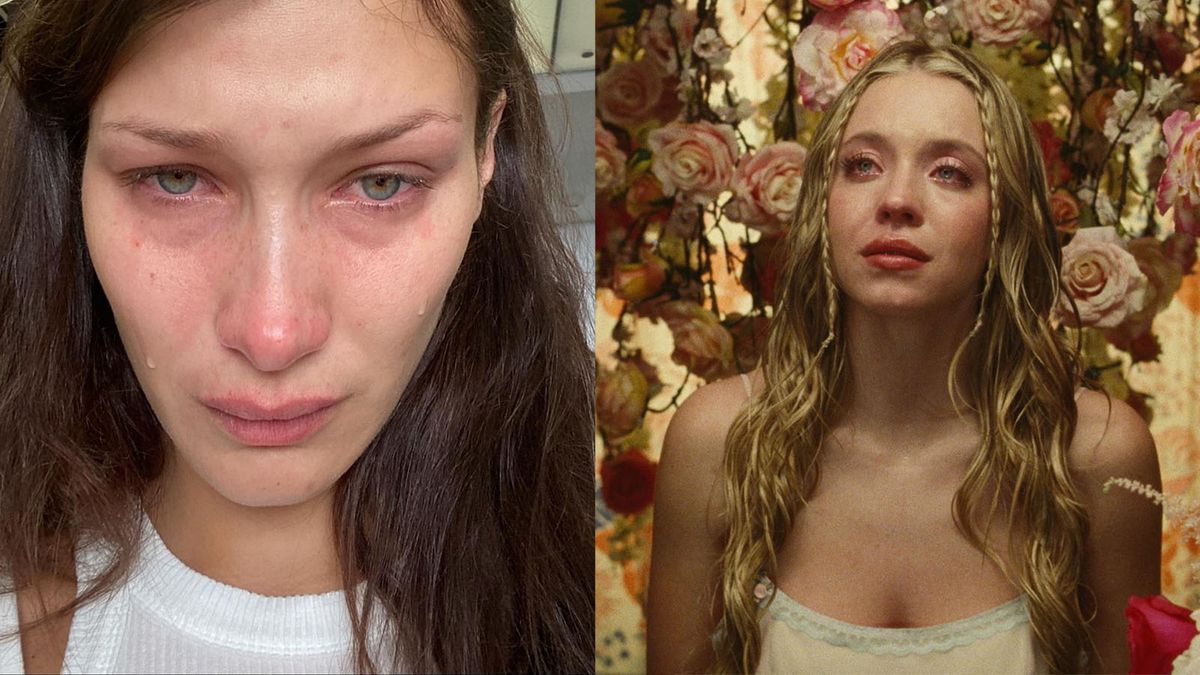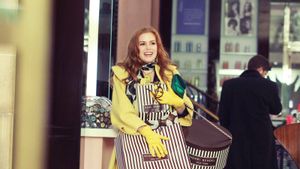Did you know that crying is now a makeup trend? Sounds absurd right to glamourise sadness? In the past, beauty magazines taught us how to conceal our sob face with makeup, but now sadness has become attractive. And yes indeed, the ‘crying makeup’ look is social media’s latest beauty trend. It features women with blush cheeks, reddened noses, and soft and puffy lips that make her appear on the verge of crying.

Crying makeup tutorials have been around for a while but enjoyed a resurgence when beauty influencer Zoe Kenealy posted a now-viral tutorial last month showing how to achieve the sad girl aesthetic with blush, some gloss and glitter shadow. While the origins of the trend are up for debate on social media, it allegedly has roots in celebrities posting crying selfies on Instagram. But is it actually leading to more vulnerability online? However, what was supposed to promote authenticity and conversations regarding mental health may have somehow sucked it out of it.
Why ‘crying girl makeup’ is problematic
While the makeup trend involves using an excess amount of blush to make the face appear more flushed than usual as you’ve just bawled your eyes out but still look conventionally beautiful. As a result of this trend, one is encouraged to let go of the notion that feelings and emotions aren't commodities that can be manipulated to gain likes and views.
This new makeup trend could be the epitome of all that is wrong with social media — a misrepresentation of what sadness actually looks like. “While the whole concept of sadness being used as an aesthetic has been around for a while, this trend comes with a great risk of trivialising and romanticising emotional breakdowns,” notes clinical psychologist Mehezabin Dordi of Sir HN Reliance Foundation Hospital, Mumbai. “For individuals who are struggling with feelings of sadness and despair, it can feel trivialising to see people trying to look like they are struggling only for aesthetic purposes,” explains Dordi.

The idea that one needs to look pretty even while facing struggles seems outrageous. I don’t think when most of us cry, our main goal is to look pretty. But in the first place, what is the necessity to look pretty after or during a good cry? “If it were really to happen like that, imagine the kind of additional pressure a person will be experiencing because of this. It is just an unnecessary standard that is put across. We don't have to multitask with our emotions,” says psychologist Vamakshi Painter of MPower - The Centre, Mumbai.
Let’s be real: this is not actually how anyone looks after a good sob. I don't know about you, but when I sob, there's not much cuteness involved. I have runny mascara, swollen eyelids and blotchy skin — it almost makes me look like a deflated party balloon. While numerous movies depict women daintily wiping away a single, glistening tear as it gently slides down their cheeks, I don't think women or anyone in real life cry like that.
Dordi shares, “The trend attaches itself to the stigma around women's vulnerabilities. The problem here is that it is not an accurate depiction of grief which fuels an unrealistic expectation that women should look a certain way even whilst crying.”
The growing trauma-feeding culture on the internet
While makeup is a form of art in itself — like an artist’s painting where the face is a canvas — you may argue that the trend is just about getting creative and playing around with your products. But, doesn’t it set a dangerous precedent to fetishise sadness?

“Using sadness and trauma as a basis to elicit allure and attraction has been carried out subliminally in many art forms. Recently, a relatively new term has come up called ‘trauma feeding’ within contemporary artistic practices,” points out Dordi. “Trauma-feeding essentially refers to the practice of making art about trauma that has the obvious effect of soliciting people’s sympathy and, possibly, stirring up more trauma or trauma-related effects in spectators to generate buzz and interest,” explains Dordi.
But this preoccupation with the sad girl exists in a lot of places. Are you a fan of literature? Look no further than Sylvia Plath or Virginia Woolf. Like to listen to pop music? Anyone’s go-to sad girl would be Lana Del Rey. And if you’re looking for more variety, there are countless other familiar names in the official Spotify-curated playlist titled ‘sad girl starter pack’ which has almost a million likes.
While most of us might have rolled down our car windows or stared into oblivion while listening to Del Rey or found solace reading Plath, to now use rhinestones or crystals to mimic tears seems excessive. This kind of glamorisation of sadness is not aesthetic or appealing.

"However, now, the romanticisation of mental illness is an awful attempt at making them beautiful, edgy and cool. What romanticisation does is it creates a glamorous and fancy portrayal of mental illness. Social media is particularly awful in creating this distorted image of mental health that is sometimes appealing to people, making it an ‘aesthetic’,” Dordi highlights.
When makeup artist Zoe Kim Kenealy posted this makeup tutorial video on TikTok, it went viral having over 130 million views and over 2 million views on Instagram. With beauty content like this, the topic of destigmatising mental health conversations has turned into making them seem 'desirable'. It is imperative for us, as a society, to realise that making mental illness seem desirable is every bit as dangerous as trivialising it.
“My belief is that being creative cannot be romanticised as a result of sadness or being in pain. Even if one is going and exploring themselves in the phase of sadness, are they able to express themselves in the same way later as well or is it just a momentary expression?”, Painter rightfully questions.
The deeper issues with these trends
Intentionally or not, the crying makeup trend might raise many other concerns that may anaesthetise us to real trauma. “It is even possible that trends like these could contribute further to the stigma attached to mental illness or the belief that people who struggle with low mood could be acting or exaggerating their feelings. This is especially worrying as people may also fear that they wouldn’t be believed when they speak about their issues, which happens to be one of the biggest barriers in terms of seeking professional help,” Dordi explains.
In a world where conversations about mental health struggles are acquiring acceptance gradually, it is even possible that trends like these could contribute further to the stigma attached to mental health struggles.

In recent times, many people have chosen platforms like Instagram to share their feelings, vulnerabilities and express emotions. “A person expressing sorrow on the internet could be really crying for help which should not be ignored,” says Painter. “It is demeaning to showcase trauma as an act to look glamorous on the internet because it is not a joke.”
The sad girl aesthetic and the commodification of female frailty seem to be very much alive on screen with shows like Euphoria showcasing characters that struggle with similar narratives. In addition, there is a deep sense of unease surrounding the ramifications of this.
While a wave of celebrities including Bella Hadid and Dua Lipa have often taken to Instagram and posted images of themselves amid a vulnerable moment, it wasn’t necessary for us to make a visually-appealing trend out of it. Many have spoken about their struggles with mental health but only in an attempt to encourage conversations around mental health.
“There have been very stark differences in opinions about these trends. On one end of the spectrum, it is viewed as another form of vulnerability porn or ‘sadfishing’, a term for posting sad content online to garner sympathy, seek support or drive engagement. And on the other end of the spectrum, it is viewed as brave and being able to break through the stigma and be more authentic,” Dordi shares.
No doubt, social media allows creators to push the boundaries of makeup, and beauty trends are truly fleeting. But is it healthy to sensationalise grief and marginalise psychological pain to turn our inner struggles into nothing more than just cute looks? It's unfortunate, but even our favourite highlighters can't permanently solve our problems.




